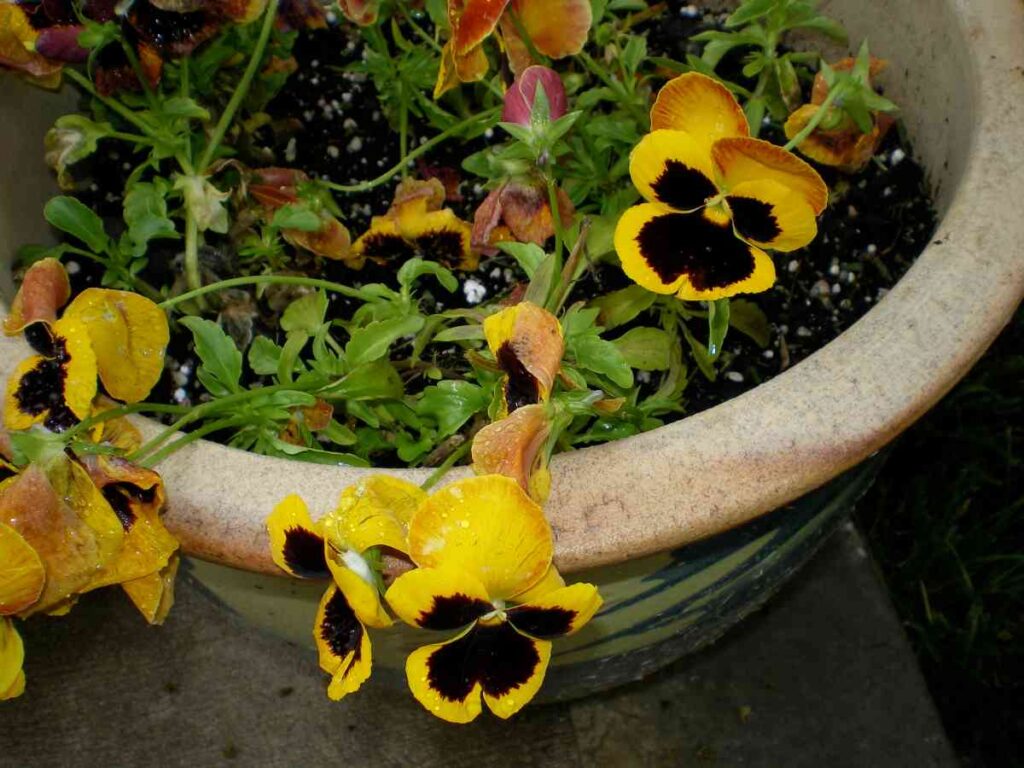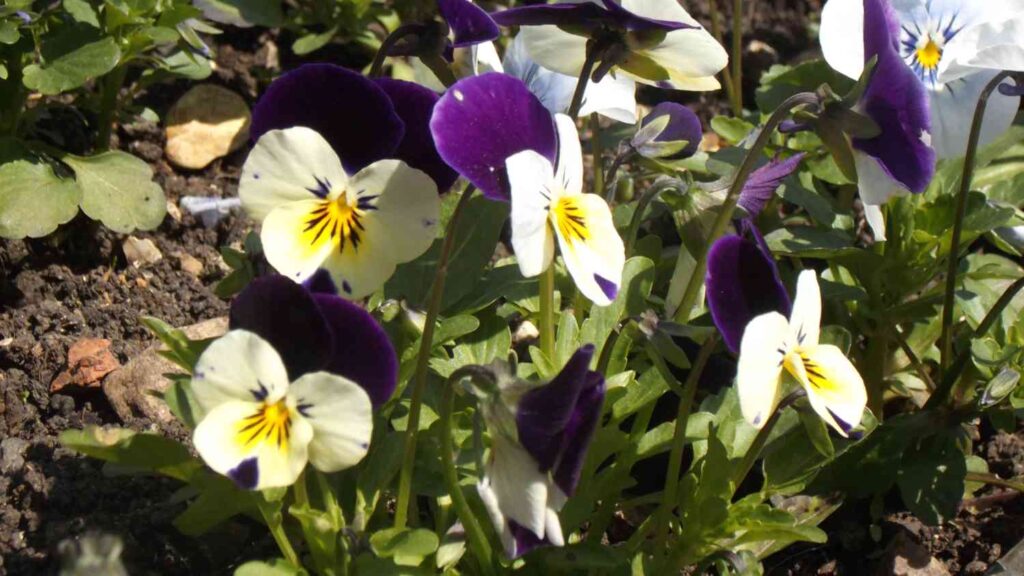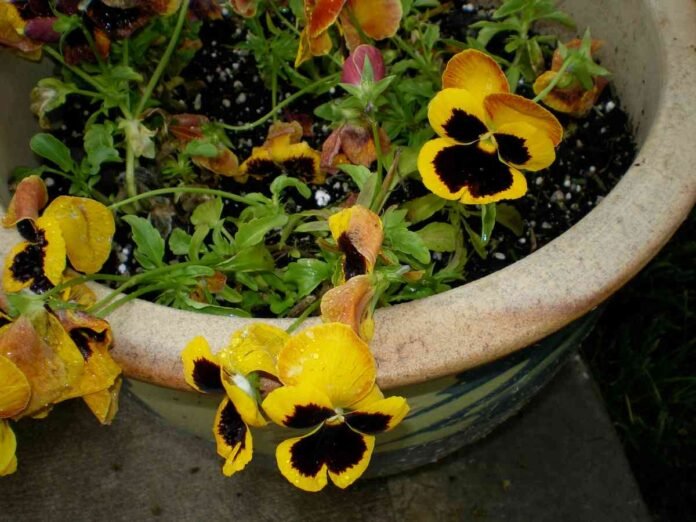When all your summer plants started to fizzle out in some way, it’s time to start planting pansies in the fall to go through winter.
Renowned for its vibrant coloured blooms and heart shaped leaves, pansies add charm to your backyard garden especially in cool months.
Pansies are annual flowering plants that thrives in cool temperatures, making them ideal for planting in early fall or late winter.
It’s easy to grow pansies in pots or garden beds.
As the plant can’t tolerate extreme heat, it’s recommended to grow pansies in partial shade with rich soil.
To have a successful blooming period, you must take proper care of pansies, which include adequate watering, well-drained soil, balanced fertilizer and shading from extreme sunlight.
Mulching and removing faded blooms encourage lushy growth and continuous flowering throughout the blooming season.
Can I Grow Pansies in Pot?

Yes, you can plant pansies in container or pots, planters, and window boxes.
Their compact size and shallow root system make them perfect for container cultivation, allowing you to enjoy their colorful blooms on patios, balconies, or doorsteps.
- Potted pansies must be planted in pots with adequate drainage holes to prevent waterlogging, which can harm the roots.
- Use a high-quality, well-draining potting mix and position your containers where they’ll receive 4-6 hours of sunlight daily.
- In warmer climates, some afternoon shade can help protect the flowers from heat stress.
Though potted pansies require regular watering, you shouldn’t overwater them as it can result in root rot.
During cooler months, check the soil moisture every few days, as potted plants dry out faster than garden beds. With proper drainage, quality soil, and regular care, potted pansies will have a successful blooming period.
Also Read: How to Grow and Care Columbine Plant?
Best Container for Pansies
Pansies’ compact size, shallow roots, and cold tolerance make them perfect for containers. Growing pansies in pots offers better control over soil, drainage, and placement than traditional garden beds.
While pansies thrive in various containers, drainage is critical—they’re sensitive to waterlogging and develop root rot without adequate holes.
While pansies can grow in tiny containers like teacups, smaller pots require more frequent watering, sometimes multiple times daily in sunny or windy locations. For easier maintenance, opt for larger containers that retain moisture longer and provide more root space for healthy growth.
Avoid porous materials like unglazed ceramic in freeze-thaw conditions, as they crack. Choose weather-resistant materials for outdoor winter displays.
Planting Your Pansies
Plant pansies in fall (October) for best results, allowing root establishment before winter. Spring planting should occur early while temperatures stay cool.
Water seedlings beforehand to reduce transplant stress. Gently separate roots when removing from containers and plant at original depth with crowns above soil level.
Space plants adequately for air circulation, leaving few inches between them. Containers allow closer spacing than garden beds but still require proper ventilation to prevent disease.
Water thoroughly after planting to settle soil and eliminate air pockets around roots.
How to Care for Pansies in Pots?
Most crucial aspect of growing pansies is taking care of them. Without minimal care you won’t be able to have a healthy plant.
Below mentioned are detail Pansies plant caring tips.


Soil Requirements
Quality potting soil is essential for container pansy success. Never use heavy garden soil—select light, all-purpose potting mix with organic matter instead. Ideal soil should be well-draining yet moisture-retentive, with pH 6.0-6.5.
Choose mixes containing slow-release fertilizer for steady nutrition. Enhance with worm castings or compost for added nutrients.
When filling containers, leave 1-2 inches below the rim to create a water basin, preventing soil washout and making watering more efficient.
Watering Requirements of Pansies
Proper watering is crucial for container pansy success.
Pansies need consistent moisture but are extremely sensitive to waterlogged conditions. The key is maintaining soil that’s always moist but never soggy. This delicate balance requires attention and adjustment based on weather conditions.
Container-grown plants dry out faster than those in garden beds, making regular monitoring essential. Check soil moisture daily by inserting your finger about an inch into the soil. If it feels dry, it’s time to water.
- During active growing seasons, potted pansies need watering once or twice daily, depending on weather conditions. Sunny or windy locations require more frequent watering than cooler, shadier spots.
- Use rainwater when possible; let tap water sit overnight to dissipate chlorine. Water early morning to reduce disease risk. Apply water slowly until it drains from bottom holes, ensuring complete root zone moisture.
- Watch for overwatering signs: yellowing leaves, soft stems, or fungal growth. Underwatered pansies wilt with brittle leaves. Use saucers but empty regularly to prevent standing water.
Check this: How to Grow Celosia?
Fertilizing Pansies
While pansies are relatively frugal regarding nutrient requirements, container plants need regular fertilization because potting soil lacks the natural nutrient cycling found in garden beds.
The enclosed growing environment means nutrients wash away with each watering, making supplemental feeding essential for optimal blooms.
- Use balanced fertilizers with equal NPK ratios like 10-10-10 or 20-20-20 for best results. These provide nitrogen, phosphorus, and potassium, supporting foliage growth and flower production.
- Slow-Release Fertilizers: Mix granular fertilizer into potting soil before planting or apply to surfaces. Products like Osmocote provide steady nutrition for months.
- Liquid Fertilizers: Apply water-soluble fertilizers every 2-3 weeks during active growth. Fish emulsion offers organic nutrition, while Miracle-Gro provides synthetic convenience. Water plants before applying to prevent root burn.
- Organic Options: Blood meal, worm castings, and compost provide gentle, long-lasting nutrition while improving soil structure.
Begin fertilizing one week after planting. Fertilize every 2-4 weeks during active seasons, reducing frequency in summer heat. Always water thoroughly after application and monitor for over-fertilization signs.
Light and Temperature Requirements
Pansies perform best in full sun to partial shade, requiring 4-6 hours of direct sunlight daily for optimal flowering.
Morning sun is particularly beneficial, as it helps dry dew from leaves and reduces disease risk. In warmer climates, afternoon shade can protect plants from heat stress while still providing adequate light for blooming.
Position containers where they’ll receive appropriate light throughout the day.
Remember that light conditions change with seasons, so you may need to relocate containers as the sun’s angle shifts. Too much shade reduces flower number and size while making plants leggy and weak.
Also Read: How to Propagate Zinnias?
Temperature
One of pansies’ greatest assets is their remarkable cold tolerance. These hardy plants can withstand temperatures as low as 15°F, making them ideal for year-round container displays in many regions. However, if temperatures are forecast to drop below 15°F, bring containers indoors temporarily.
During summer heat, pansies struggle and often stop blooming when temperatures consistently exceed 80°F.
In hot climates, move containers to locations with morning sun and afternoon shade, or replace pansies with heat-tolerant annuals for summer months.
Pruning and Deadheading
Regular deadheading extends blooming periods and keeps plants tidy by preventing seed formation.
Remove faded flowers by cutting stems back to the next set of leaves, not just flower heads. This pinching technique promotes bushier growth with more flowering stems.
Check plants every few days during peak seasons, as most varieties benefit from regular deadheading.
If pansies become leggy or stretched, pinch back overly long stems to encourage bushier growth. This is particularly important in containers where compact, full plants are more attractive.
Don’t be afraid to trim pansies back significantly; they recover quickly and often produce more flowers after pruning.
Pest and Disease Management
While pansies are generally pest-resistant, container plants face specific challenges. Aphids are the most common pest, appearing on new growth in spring. Several species attack pansies, including green peach and violet aphids. These insects multiply rapidly, making early detection crucial.
Spider mites become problematic during hot, dry weather, causing tiny pinpricks on leaves that become brown spots. Severe infestations produce webbing and leaf death.
Encourage beneficial insects like ladybugs, parasitic wasps, and lacewings by planting nearby attractive flowers. Queen Anne’s lace effectively draws natural predators.
For immediate control, use insecticidal soap sprays weekly. These gentle treatments control soft-bodied insects without harming beneficials. Food-grade diatomaceous earth also controls aphids naturally.
Most diseases result from excessive moisture or poor air circulation. Prevent fungal problems by watering at soil level, ensuring adequate plant spacing, and providing good air circulation.
Slugs and snails feed nightly, leaving irregular holes and slimy trails. Check containers regularly and remove hidden mollusks.
Also Read: How to Grow Blanket Flower?
Potted Pansies Caring Tips
1. Fall Planting: Fall is ideal planting time for pansy containers. After planting, maintain consistent moisture and begin regular fertilizing. Reduce watering frequency as temperatures cool but keep soil from drying completely.
2. Winter Protection: Before hard freezes, water deeply and consider covering containers or moving them to protected areas like unheated garages during extremely cold weather.
3. Spring Revival: When spring arrives, give overwintered pansies thorough watering and resume fertilizing. Deadhead winter-damaged flowers and assess plant health. Plant new pansies early while temperatures stay cool.
4. Peak Growing Season: As daylight increases and temperatures warm, pansies experience growth surges. Maintain consistent care routines and enjoy peak bloom displays during this period.
5. Summer Heat Management: When temperatures consistently exceed 80°F, pansies become stressed and stop flowering. Transition to heat-tolerant summer annuals or move containers to cooler, shadier locations.
6. Cold-Hardy Varieties: Some pansy varieties are bred for enhanced cold tolerance and can survive harsh winters better. Research varieties suited to your climate zone for reliable winter performance.
7. Container Insulation: During extreme cold, insulate containers with burlap or bubble wrap to prevent root damage. Move containers to ground level and group them together for mutual protection.
8. Winter Maintenance: Check soil moisture periodically and water lightly if very dry. Remove dead foliage to prevent disease. Watch for new growth as days lengthen.
9. Common Problems: Poor blooming usually indicates insufficient light, heat, or nutrition. Wilting in watered plants suggests root problems from overwatering. Overcrowded containers reduce flowering and need plant thinning.
Conclusion
Caring for pansies in pots brings months of colorful blooms to outdoor spaces. These resilient flowers thrive with proper drainage, quality soil, consistent moisture, and appropriate nutrition.
Success requires understanding their preferences for cool weather and bright light while avoiding overwatering and excessive heat.
Outstanding container pansies need attention to detail: appropriate containers, consistent watering, regular fertilization, and routine deadheading.
With proper care, potted pansies provide reliable fall-through-spring color, creating beautiful displays that enhance patios, balconies, and entryways throughout cooler months.


Khaja Moinuddin, a computer science graduate, finds joy in gardening and homesteading. Join him on this blog as he shares his experiences in homesteading, gardening, and composting


